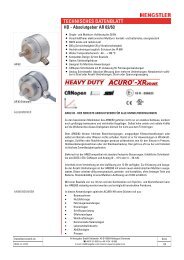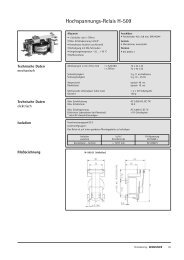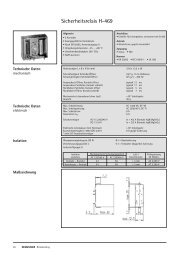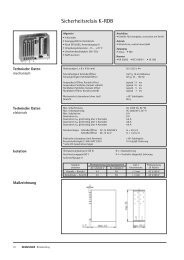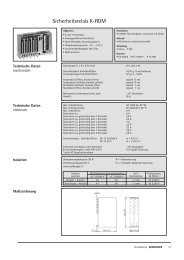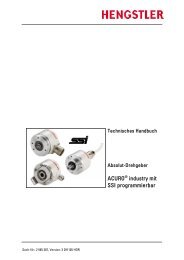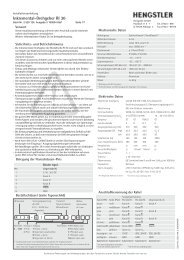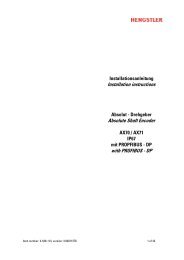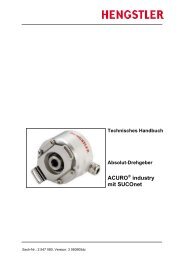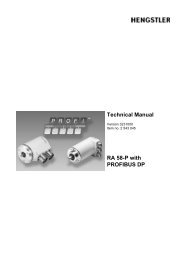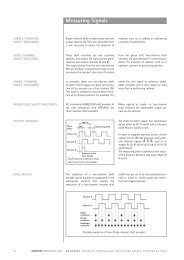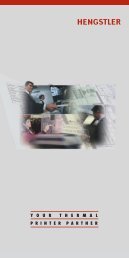XPM 200HR™ v1 - Hengstler GmbH
XPM 200HR™ v1 - Hengstler GmbH
XPM 200HR™ v1 - Hengstler GmbH
Create successful ePaper yourself
Turn your PDF publications into a flip-book with our unique Google optimized e-Paper software.
<strong>XPM</strong> 200HR Thermal Printer Family HENGSTLER ®<br />
The through-beam sensor can also be used in a manner similar to a Black Mark<br />
sensor. Instead of a Black Mark, a hole is used in the paper. The through-beam<br />
sensor is located in one of 19 different possible locations. The positions of these<br />
sensors are detailed in the Figure 14.<br />
3.5.4. “Printhead Raised” Sensor<br />
Two additional “Printhead Raised” microswitches are used to determine whether the<br />
printhead is in the up (do not print) or down (ready to print position). (Please note<br />
that these microswitches are wired in series, and so will only report “ready to print” if<br />
both are closed.) Normally, most of the heat generated by thermal printing is<br />
transferred to the paper being printed and is removed from the printer as the paper<br />
advances. When the printhead is up, no heat is being transferred to the paper and<br />
the heat remains in the individual dots, allowing them to overheat if activated<br />
repeatedly. Because this may cause permanent damage to the printer, the<br />
<strong>XPM</strong> 200HR firmware will prevent printing or paper loading if the head is up.<br />
The output of this microswitch pair is also available via the Query function. See the<br />
<strong>XPM</strong> 200HR Emulation Command Set Reference D 690 004 for details on<br />
determining the printhead position and the printhead temperature.<br />
3.5.5. Cutter Sensors<br />
The <strong>XPM</strong> 200HR uses a “pizza-cutter” style paper cutter. A cutting disk moves<br />
from one side to the other to sever the paper from the roll against a stationary blade.<br />
Sensors are located at the end of travel for this cutter so the controller can detect<br />
where the cutter blade is and determine in which direction it should be moved to cut<br />
the paper. Printer throughput time is improved by cutting in both directions,<br />
eliminating the need for the cutter to make a non-cutting movement to an arbitrary<br />
“home” position.<br />
3.5.6. Paper Exit Sensor<br />
A sensor on the exit side of the print mechanism detects when paper has passed<br />
through the cutter assembly and reached the paper exit.<br />
3.5.7. Paper Pre-End (Paper Low) Sensors<br />
The <strong>XPM</strong> 200HR has inputs for two pair of sensors indicating Paper Pre-End<br />
(Paper Low). (Pairs of inputs are used to allow connection, in other applications, to a<br />
dual-feed unit, which can handle two paper sources. In that case, one Paper Pre-End<br />
input is used for each paper source.) One sensor pair is used to detect standard<br />
Paper Pre-End (PPE). Connected to appropriately selected sensor, and positioned<br />
the desired distance from the end of the paper supply, it will signal via a query<br />
through the interface when paper has become low enough to activate this signal.<br />
This is normally used to allow time to change an almost empty paper roll before it is<br />
exhausted. This is an analog sensor input that is converted to a digital signal via<br />
analog to digital (A/D) conversion. Therefore, it is possible to read their analog<br />
values and use this information as a measure of sensor obstruction.<br />
The second sensor pair is also for Paper Pre-End, but is intended for use as what is<br />
commonly called a “weekend sensor” (PWE). While the standard PPE sensors<br />
detect when paper has reached some user-defined point where a paper change will<br />
be required shortly, PWE sensors are usually set to signal whether there is enough<br />
paper remaining to make it through the weekend without replenishing the paper. This<br />
is especially useful for installations where there is no staff available to change the<br />
paper over the weekends. The PWE input is a direct digital input. Since no supply is<br />
provided to power an LED-style sensor, these inputs are best used with a<br />
microswitch.<br />
Part No. D 690 074 Mod. No. 4 300113 LEV page 15 of 32



